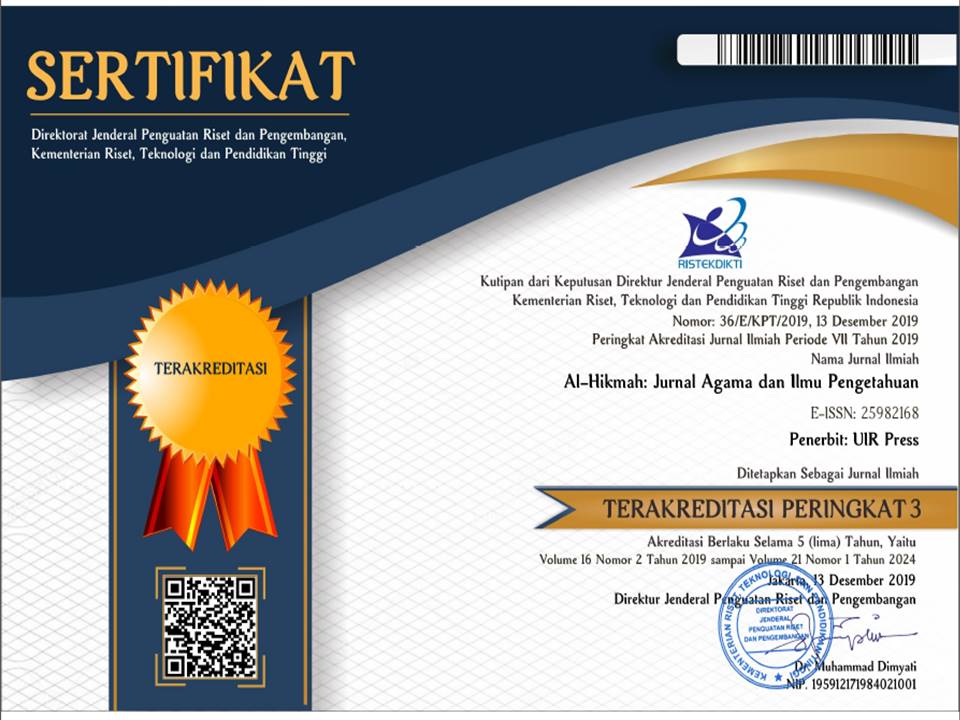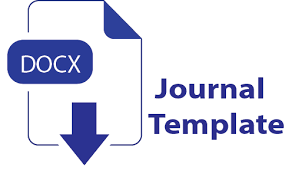Grammatical Issues In The Holy Qur'an About Human Creation
DOI:
https://doi.org/10.25299/al-hikmah:jaip.2024.vol21(1).15854Keywords:
Gramatikal Bahasa Arab, Penciptaan Manusia, Tafsir al-Qur’an, Interdisipliner, Temuan Ilmiah ModernAbstract
Penelitian ini berfokus pada analisis isu-isu gramatikal bahasa Arab dalam Al-Qur'an terkait penciptaan manusia, dengan mengeksplorasi interpretasi dari empat kitab tafsir utama (al-Kasysyaf Zamaksyari, al-Bahr al-Muhith Abu Hayyan al-Andalusy, Tafsir al-Qur’an al-‘Azhim Ibnu Katsir, Ruhul Ma’ani al-Alusy) dan membandingkannya dengan temuan ilmiah modern. Melalui metode analisis linguistik, analisis tafsir, serta pendekatan interdisipliner yang menggabungkan prinsip-prinsip teologi, linguistik, dan ilmu pengetahuan, penelitian ini bertujuan untuk mengungkap kesesuaian dan perbedaan antara narasi Al-Qur'an dan pemahaman ilmiah tentang penciptaan manusia. Temuan utama menunjukkan adanya kesesuaian dan perbedaan signifikan, serta menyoroti keragaman interpretasi dalam tafsir. Penelitian ini menggarisbawahi pentingnya pendekatan interdisipliner dalam memahami teks-teks agama, memberikan kontribusi yang signifikan terhadap pemahaman tentang penciptaan manusia.
Downloads
References
Abdullah, M. M. A., & Mazahir, S. M. M. (2023). Human Relations in Multicultural Societies: An al-Qur’anic Overview. Spring Journal of Arts, Humanities and Social Sciences, 01(December 2022), 18–27. https://doi.org/10.55559/sjahss.v1i12.69.
Adhiguna, B., & Bramastia. (2021). Pandangan Al-Qur’an Terhadap Ilmu Pengetahuan Dan Implikasinya Dalam Pembelajaran Sains. INKUIRI: Jurnal Pendidikan IPA, 10(2), 137–144. https://doi.org/10.20961/inkuiri.v10i2.57257.
Afifi, S., & Nuryana, K. I. (2020). Ragam Komunikasi Verbal dalam Al-Qur’an. Jurnal Komunikasi, 15(2), 153–171. https://doi.org/10.20885/komunikasi.vol15.iss2.art6.
Afkarina, R. H., & Kurniawan, R. R. (2022). Proses Penciptaan Manusia Menurut Ilmu Sains Dan Al-Qur’an. Ulumul Qur’an: Jurnal Ilmu Al-Qur’an Dan Tafsir. https://osf.io/preprints/osf/w8c2p.
Al-Alusi, M. bin A. (1270). Ruh al-Ma’ani fi Tafsir al-Qur’an al-’Azhim wa al-Sab’ al-Mathani. Dar al-Kutub al-’Ilmiyyah.
Al-Ameedi, R. T. K., & Al-Tamimi, A. K. M. (2022). A Stylistic Study of Subjugation in Quranic Texts. ELS-JISH, 5(3), 551–562. https://doi.org/https://doi.org/10.34050/elsjish.v5i3.23243.
Al-Andalusi, M. bin Y. A. H. (745). al-Bahrul Muhith fi at-Tafsir. Dar al-Fikr.
Al-Hamoud, M. M. S. (2022). Rational Arguments in Response to the Suspicions of Atheists on the Issue: (The creation of man, the purpose of his existence, and his destiny). Journal of the College of Islamic and Arabic Studies for Girls in Damanhur, 7(5), 19–84. https://doi.org/https://doi.org/10.21608/jcia.2022.287983.
Al-Samahi, A.-B. A. B. H. (2020). An applied study of grammatical clarifications in the Noble Qur’an. Journal of the College of Arabic Language in Girga, 24(7), 6343–6524. https://doi.org/https://doi.org/10.21608/bfag.2020.106559.
Al-Zamakhsyari, J. M. bin U. (1431). Tafsir al-Kashaf ’an Haqaiq al-Tanzil wa ’Uyun al-Aqawil fi Wujuh al-Ta’wil. Dar al-Kutub al-’Ilmiyyah.
Ariawan, S., Solehuddin, M., Rizaq, M., Warman, A., & Fathurohman, A. (2022). Peran Al-Quran Dalam Meningkatkan Pemahaman Pembelajaran Qur’an Hadits. El -Hekam, 7(2), 278–294. https://doi.org/10.31958/jeh.v7i2.8608.
Azizah, U. N., & Juwariyah, T. (2022). Abdullah Yusuf Ali’s Methodology of Interpretation (Linguistic Tafsir The Holy Of Qur’an). ICIIS and ICESTIIS 2021. https://doi.org/10.4108/eai.20-10-2021.2316349.
Bakhit, H. M. M. (2022). Emphatic particles in the Arabic language “A grammatical semantic study in the Holy Quran.” International Journal of Health Sciences, 6(S1), 3613–3633. https://doi.org/https://doi.org/10.53730/ijhs.v6nS1.5523 E.
Chukhanov, S. (2024). The importance of a semantic approach in understanding the texts of the Holy Quran and Sunnah. Pharos Journal of Theology, 105(3), 1–11. HTTP//: www.pharosjot.com.
Fauzan, U. R., & Zinira, M. (2022). Makna Ja’ala Dan Khalaqa Pada Ayat-Ayat Jodoh Studi Pendekatan Hermeneutika Paul Ricoeur. Syariati, 8(01), 97–108. https://doi.org/https://doi.org/10.32699/syariati.v8i2.3504.
Fayyad, W. A. (2024). Quranic grammar in the light of a new approach (almdwwnt almghlq). Alustath Journal for Human and Social Sciences, 222(1), 91–113. https://doi.org/https://doi.org/10.36473/ujhss.v222i1.369.
Ghayehbashi, S. E. (2021). Analysis of The Theory of Embryo Formation from Male Sperm and Lack of Attention to Female Sperm in Quranic Verses. International Journal of Multicultural and Multireligious Understanding, 8(3), 118–130. https://doi.org/http://dx.doi.org/10.18415/ijmmu.v8i3.2393.
Hammadi, S. S. (2023). A Cognitive Semantic Analysis of Selected Quranic Verses. Midad Al-Adab, 13(32), 985–1004. https://doi.org/https://doi.org/10.58564/ma.v13i32.1100.
Hasanudin, A. S. (2022). Tafsir Al-Qur’an dengan Bahasa Arab. Jurnal Iman Dan Spiritualitas, 2(4), 611–618. https://doi.org/10.15575/jis.v2i4.19033.
Ibn Kathir, I. bin U. (774). Tafsir al-Qur’an al-Azhim. Dar Taybah.
Islamiyah. (2020). Manusia dalam Perspektif Al-Qur'an (Studi Terminologi al-Basyar, al-Insan dan al-Nas). RUSYDIAH: Jurnal Pemikiran Islam, 1(1), 41–58. https://doi.org/10.35961/rsd.v1i1.126.
Kaukab, M. E. (2021). Al-Qur’an dalam Pemahaman Muslim Kontemporer. Syariati : Jurnal Studi Al-Qur’an Dan Hukum, 7(1), 33–42. https://doi.org/10.32699/syariati.v7i1.1850.
Kiptiyah, K. (2018). Embriologi Dalam Al-Qur’an: Kajian Pada Proses Penciptaan Manusia. ULUL ALBAB Jurnal Studi Islam, 8(2), 163–188. https://doi.org/10.18860/ua.v8i2.6201.
Musling, M. N., & Ismail, M. Z. (2021). Universal Social Moral Values in Shahid of Quranic Syntax: Nominal and Verbal Sentences. International Journal of Academic Research in Business and Social Sciences, 11(12), 738–756. https://doi.org/10.6007/ijarbss/v11-i12/11816.
Rohanimashhadi, F. (2020). ‘Adam’s Istifā’ in Qur’an and human evolution. HTS Teologiese Studies/Theological Studies, 76(1), 1–8. https://doi.org/https://doi.org/ 10.4102/hts.v76i1.5795.
Sholihah, N. A. (2017). Stilistika Morfologi Dalam Ayat-Ayat Penciptaan Manusia. AL ITQAN: Jurnal Studi Al-Qur’an, 3(2), 1–26. https://doi.org/10.47454/itqan.v3i2.25.
Subagiya, B., Hafidhuddin, D., & Alim, A. (2018). Internalisasi Nilai Penciptaan Manusia Dalam Al-Quran Dalam Pengajaran Sains Biologi. Tawazun: Jurnal Pendidikan Islam, 11(2), 190–210. https://doi.org/10.32832/tawazun.v11i2.1674.
Sutoyo, A., Mahmudah, U., & Abu Bakar, A. Y. (2022). Understanding Human Nature from Quranic Perspective. INDONESIAN JOURNAL OF EDUCATIONAL RESEARCH AND REVIEW, 5(1), 16–24. https://doi.org/http://dx.doi.org/10.23887/ijerr.v5i1.44944.
Wajdi, M. B. N., Husniyah, N. I., Ahmad, V. I., Putra, M. I. S., & Syarofi, A. M. (2023). Understanding the Quran Holistically: Interdisciplinary Study of the Language and Linguistics of the Quran. BASA Journal of Language & Literature, 3(1), 11–17. https://doi.org/10.33474/basa.v3i1.19596.
Wajih, M. A. M. (2019). The Role of Arabic Grammar in Understanding and Appreciating the Qur’an. Journal of Qur’anic Studies, 21(1), 169–198. https://www.euppublishing.com/doi/full/10.3366/jqs.2019.0376?role=tab.
Yaacob, S. (2014). Critical Study of Arabic Grammatical Thinking. Dar Salam. Egypt.
Yaacob, S. (2016). Lingua Revolution and Human Civilization (Special Season). Kuala Lumpur.
Yaacob, S. (2018). The Origin of Language, Human Civilization, and Its Connection to Ethnic Groups and the Malay Language. Jurnal Seri Alam, 1. Kuala Lumpur.
Yaacob, S. (2020). Adam’s Genealogy: A Handbook. SH Lingua Edu Enterprise. Kuala Lumpur.
Zaino, A. A., & Abbas, M. Y. (2020). Blue-Space Restoration Theory extends the Understanding of the Quranic Verses of Water. AMER ABRA CE-Bs, 327–334. https://doi.org/https://doi.org/10.21834/ebpj.v5i14.2195.





